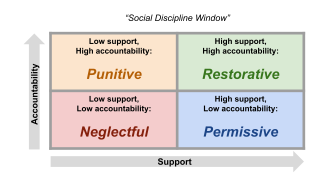Restorative Framework
Part of Right Relationship Teams

Paul McCold and Ted Wachtel articulated the social discipline window framework as a tool to reflect on power dynamics in communities.
This mental model can be helpful in understanding different patterns of how we might respond when someone is causing harm in our communities.
The model has four quadrants of how a community might respond to a person who has caused harm, with the horizontal axis being how much support is given to the person, and the vertical axis being how much accountability is expected from the person.
Neglectful: Low Support, Low Accountability
- When the community doesn’t have a shared sense of appropriate behavior, members may have individual understanding of what constitutes good manners, or what behaviors are acceptable. People feel free to behave however they want, and can cause harm. No one in the community is empowered to provide direction, support, or accountability for the situation. The people who experience or observe the harm see the community neglecting the thriving and safety of some of its members. Some will see harmful behaviors as the norm and will feel free to engage in them. Others will feel anxious or fearful, and will leave.
Permissive: High Support, Low Accountability
- When a community articulates its ideals about how each person has inherent worth and dignity, and may have a covenant, but doesn’t actually address situations where covenant is broken or harm happens, the community is giving implicit permission for the problematic behaviors to continue. Often, when someone with more power and/or priviledge acts harmfully to someone with less power and/or priviledge, leaders downplay the harm, claiming good intentions, suggesting that the harmed person is overreacting, or excusing the behavior as a quirky, unchangeable personality trait. Even though the community talks about ideal behaviors, the people with less power and/or priviledge feel that they don’t matter, don’t really belong in any meaningful way, and will eventually drift away.
Punative: Low Support, High Accountability
- When a community doesn’t treat its members as having inherent worth and dignity in practice, it looks to use punishment as the only way to modify behavior. It doesn’t focus on the impact of the situation on the one harmed. It doesn’t focus on the wellbeing of the one who caused harm either, just with applying harsh consequences . Because this is the dominant model in the U.S. criminal justice system, it is often the expectation in our congregations, even though it runs counter to UU core values. Those who have experienced harm — or feel that they have — might move quickly to demanding this sort of punitive response as a way for the community to demonstrate its support of the one(s) harmed.
Restorative: High Support, High Accountability
- When a community understands that humans are complex creatures with capacity for both care and harm, it finds a way to encourage the safety and thriving of all of its members. It sets clear expectations of appropriate boundaries and behaviors, encourages the practice of deep listening and compassionate communication, and offers to restore community and repair relationships when harm has occurred (when possible). Everyone gets a chance to tell their story, to learn from their mistakes, and to have a voice in finding a way forward. Once a way forward is agreed to, the community continues to support both the one who has experienced harm and the one who has caused harm as they do the work of restoring right relationship.